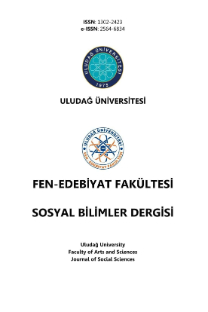THE USE OF AN INTERPRETIVE SCHEME IN EXAMINING TWO TURKISH TRANSLATIONS OF DOYLE’S “SPECKLED BAND”
Doyle’un “Speckled Band” İsimli Öyküsünün İki Türkçe Çevirisinin Bir Yorumlama Şemasıyla İncelenmesi
___
Damrosch, David (2003). What is World Literature. Princeton: Princeton University Press.Doyle, Arthur Conan (1892). Adventures of Sherlock Holmes. New York: Harper & Brothers. http://www.gutenberg.org/files/48320/48320-h/48320-h.htm#viii (Accessed: 30.04.2019).
Doyle, Arthur Conan (1992). Sherlock Holmes Ölüm Döşeğinde. Trans: Saffet Günersel, İstanbul: Metis.
Doyle, Arthur Conan (2013). Sherlock Holmes’un Maceraları. Trans: Berrak Göçer and Kaya Genç, İstanbul: Everest.
Drabble, Margaret (2000). The Oxford Companion to English Literature. Oxford and New York: Oxford University Press.
Favor, Lesli J. (2000). “The Foreign and the Female in Arthur Conan Doyle: Beneath the Candy Coating”. English Literature in Transition, Vol. 43, Iss. 4, p. 398-409.
Frank, Lawrence (1996). “Dreaming the Medusa: Imperialism, Primitivism, and Sexuality in Arthur Conan Doyle’s The Sign of Four”. Signs, Vol. 22, Iss. 1, p. 52-85.
Genette, Gerard (1997). Paratexts: Thresholds of Interpretation. Cambridge: Cambridge University Press.
Günersel, Saffet (1992). “Sir Arthur Conan Doyle (1859-1934)”. Sherlock Holmes Ölüm Döşeğinde. Author: Arthur Conan Doyle, İstanbul: Metis Yayınları, p. 7-9.
Hodgson, John A. (1992). “The Recoil of “The Speckled Band”: Detective Story and Detective Discourse”. Poetics Today, Vol. 13, Iss. 2, p. 309-324.
Jakobson, Roman (2000). “On Linguistic Aspects of Translation”. The Translation Studies Reader. Ed: Lawrence Venuti, London and New York: Routledge, p. 113-118.
Jones, Darryl (Ed.) (2016). “Introduction”. Gothic Tales. Author: Arthur Conan Doyle, Oxford: Oxford University Press, p. ix-xxxiii.
Munday, Jeremy (2001). Introducing Translation Studies. London and New York: Routledge.
Seago, Karen (2014). “Red Herrings and Other Misdirection in Translation”. The Voices of Suspense and Their Translation in Thrillers, Approaches to Translation Studies, 39. Ed: Susanne M. Cadera, Amsterdam and New York: Rodopi, p. 207-220.
Sutherland, John (2014). “Sherlock Holmes, The World's Most Famous Literary Detective” The British Library.
https://www.bl.uk/romantics-and-victorians/articles/arthur-conan-doylethe-creator-of-sherlock-holmes-the-worlds-most-famous-literarydetective (Accessed: 11.08.2019).
Tahir Gürçağlar, Şehnaz (2008a). The Politics and Poetics of Translation in Turkey, 1923-1960. Amsterdam and New York: Rodopi.
Tahir Gürçağlar, Şehnaz (2008b). “Sherlock Holmes in the Interculture: Pseudotranslation and Anonymity in Turkish Literature”. Beyond Descriptive Translation Studies Investigations in Homage to Gideon Toury. Eds: Anthony Pym, Miriam Shlesinger and Daniel Simeoni, Amsterdam and Philadelphia: John Benjamins, p. 133-151.
Toury, Gideon (1995). Descriptive Translation Studies and Beyond. Amsterdam and Philadelphia: John Benjamins.
- ISSN: 1302-2423
- Yayın Aralığı: 2
- Başlangıç: 1999
- Yayıncı: Bursa Uludağ Üniversitesi
OSMANLI AİLE YAPISININ MİLLET SİSTEMİ İÇİNDEKİ KONUMU
OBUA KAMIŞININ TÜRKİYE’DEKİ YETİŞME ALANLARI
DEMOKRASİLERDE DARBE GEÇİRMEZLİĞE YAKINDAN BAKMAK: SİVİL-ASKER İLİŞKİLERİNDE İSPANYA ÖRNEĞİ
Ekrem KAYMAZ, MEHMET ŞAKİROĞLU
TRAFİK DENEYİMLERİ VE DÜZEN SÖYLEMİ İÇİNDEN İSTANBUL’U ÜRETMEK
BURSA VAKIF KÜLTÜRÜ MÜZESİ’NDE BULUNAN KUMAŞ ÜZERİNE İŞLEMELİ HAT LEVHALARI
Doyle’un “Speckled Band” İsimli Öyküsünün İki Türkçe Çevirisinin Bir Yorumlama Şemasıyla İncelenmesi
ZAMİR /N/’SİNİN TÜRKÇEDEKİ FONEMORFOLOJİK GELİŞİMİ
DİVAN-I HÜMAYUN KARARLARINDA BURSA VAKIFLARI (1553-1649)
AKIŞKAN ZAMANIN CİSİMLEŞEN DENEYİM ALANI OLARAK BEDEN ÜZERİNE SOSYOLOJİK BİR TARTIŞMA
